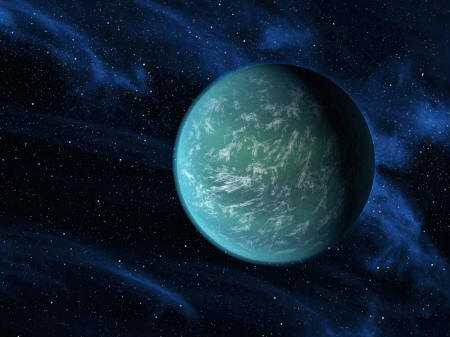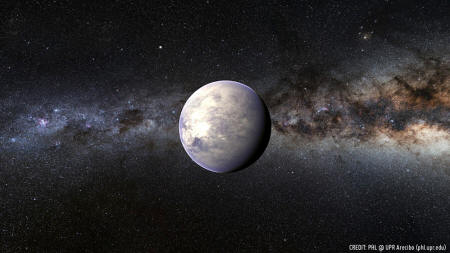1 - Kepler-186f

Credit: NASA Ames/SETI Institute/JPL-CalTech
Kepler-186f is the first truly
Earth-size exoplanet ever found in its host star's habitable
zone. The alien world, which lies 490 light-years from Earth, is
just 10 percent bigger than our own planet and is almost
certainly rocky.
2 - Gliese 581g

Credit: Lynette Cook
This planet is a controversial find.
It was discovered in 2010, but there has been difficulty in
getting it confirmed.
Still, the University of Puerto Rico at
Arecibo calls Gliese 581 the top candidate for alien life. If
confirmed, this rocky world is about 20 light-years away from
Earth's sun, and is two to three times as massive as Earth.
It
orbits its parent star,
Gliese 581, about every 30 days in the
constellation Libra.
3 - Gliese 667Cc

Credit: Carnegie Institution for Science
Another "super-Earth", Gliese 667Cc
is also close by Earth: about 22 light-years away in the
constellation Scorpius.
The planet is at least 4.5 times bigger
than Earth, and takes 28 days to make an orbit around its parent
star. GJ 667C - the parent star - is actually part of a
triple-star system.
The star is an M-class dwarf star that is
about a third of the mass of Earth's sun.
4 - Kepler-22b

Credit: NASA/Ames/JPL-Caltech
While Kepler-22b is bigger than
Earth, it circles a star that is quite close in size and
temperature to Earth's sun.
Kepler-22b is 2.4 times Earth's size
and, assuming its greenhouse effect is similar to Earth's, has
an estimated surface temperature of 72 degrees Fahrenheit (22
degrees Celsius.)
Its star system is about 600 light-years away
from Earth's sun, in the
constellation Cygnus.
5 - HD 40307g

Credit: J. Pinfield,
for the RoPACS network at the University of
Hertfordshire.
"Super-Earth" HD 40307g orbits
comfortably inside the habitable zone of its parent star. It
lies about 42 light-years away from Earth in the
constellation Pictor. It is so close by that future telescopes may be able to
peer at its surface.
It orbits its parent star about 56 million
miles (90 million kilometers) away, which is just over half of
the Earth-sun distance of 93 million miles (150 million
kilometers.)
6 - HD 85512b

Credit: ESO/M. Kornmesser
HD 85512b was announced in 2011 as
part of a treasure trove of 50 planets discovered by the High
Accuracy Radial velocity Planet Searcher instrument, or
HARPS,
in Chile.
This planet is about 3.6 times more massive than
Earth. It lives about 35 light-years away from Earth's sun, in
the
constellation Vela (the Sail). Researchers are hoping to one
day figure out if there is water on its surface.
7 - Tau Ceti e

Credit: PHL @ UPR Arecibo (phl.upr.edu)
The planet candidate Tau Ceti e,
which was detected in December 2012, is found just 11.9
light-years from Earth.
This world is a "super-Earth" at least
4.3 times as massive as Earth. Depending on its atmosphere,
Tau Ceti-e could be a mildly hot planet suitable for simple life, or
a scorching world like Venus.
8 - Gliese 163c

Credit: PHL @ UPR Arecibo
The mass of Gliese 163c puts the
planet in a gray zone.
The planet is seven times the mass of
Earth, which could make it a very large rocky planet or a dwarf
gas giant. Gliese 163c whirls around its dim planet star every
26 days, at a distance of 50 light-years away from Earth.
Its
parent star is in the
constellation Dorado.
9 - Gliese 581d

Credit: Debivort
Wikimedia Commons
At least one study supposes that
Gliese 581d might have a thick, carbon dioxide atmosphere. It is
about seven times more massive than Earth, orbits a red dwarf
star, and is a sister planet to the also-potentially-habitable
Gliese 581g.
At just 20 light-years away from the sun,
Gliese
581d is essentially in Earth's backyard.
10 - Tau Ceti f

Credit: PHL @ UPR Arecibo (phl.upr.edu)
Tau Ceti-f is a super-Earth
candidate like its sibling Tau Ceti-e, but it orbits close to
the outer edge of Tau Ceti's
habitable zone. Tau Ceti f is at
least 6.6 times as massive as Earth and could be suitable for
life, if its atmosphere traps significant amounts of heat.











